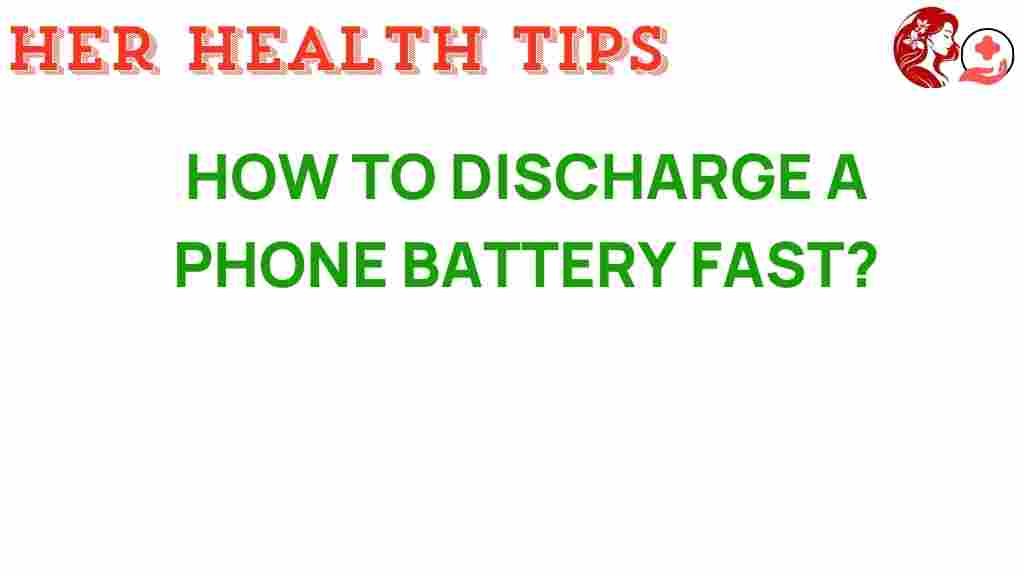Unplugged: The Secrets to Rapidly Discharging Your Phone Battery
With the rapid advancement of technology, smartphones have become an integral part of our daily lives. While we rely heavily on our devices, we often overlook the importance of managing our phone battery. In this article, we’ll explore effective ways to discharge your smartphone battery quickly, whether you’re testing its limits, troubleshooting, or simply need to reset your device. We’ll also provide you with essential tips on device care and energy-saving practices that can prolong your phone’s battery life.
Understanding Your Phone Battery
Before diving into the methods of discharging your battery, it’s crucial to understand how phone batteries work. Most smartphones today use lithium-ion batteries, which are designed to hold a charge and provide energy efficiently. However, continuous charging and discharging can affect their lifespan. Here are some key points about phone battery technology:
- Charge Cycles: A charge cycle is defined as using 100% of your battery’s capacity, but not necessarily all at once.
- Battery Management Systems: Modern devices come with built-in systems that optimize battery usage and longevity.
- Heat Management: Excessive heat can damage your battery, so avoid exposing your device to high temperatures.
Why Discharge Your Phone Battery?
There are several reasons you might want to discharge your smartphone battery:
- Testing Battery Health: Discharging your battery can help assess its performance and overall health.
- Software Updates: Some updates may require a certain battery percentage to install.
- Device Reset: A full discharge can sometimes help in resetting software issues.
Tips for Rapidly Discharging Your Phone Battery
Now that we understand the basics, let’s delve into practical tips for quickly discharging your phone battery:
1. Increase Screen Brightness
One of the most significant drains on your phone battery is the screen. To discharge your battery quickly, increase the brightness to the maximum level:
- Go to Settings.
- Select Display and adjust the brightness slider to the highest setting.
2. Use Power-Intensive Apps
Launching power-intensive applications can rapidly consume battery life. Consider the following:
- Play graphics-heavy games.
- Stream videos in high-definition.
- Run multiple apps simultaneously to maximize resource usage.
3. Disable Battery Saver Settings
If you have energy-saving features enabled on your device, it’s time to turn them off:
- Navigate to Settings and select Battery.
- Disable any battery saver options.
4. Enable Location Services
Location services can drain your battery significantly. To increase discharge rate, keep GPS and location services activated:
- Open Settings.
- Select Location and set the mode to High Accuracy.
5. Connect to Bluetooth Devices
Using Bluetooth connections can also drain your battery. Turn on Bluetooth and connect to multiple devices:
- Go to Settings.
- Select Bluetooth and make sure it’s turned on.
- Connect to headphones, smartwatches, or other accessories.
6. Stream Music or Videos
Streaming services such as Spotify or Netflix can quickly use up battery life. Choose a high-quality stream for maximum impact:
- Open your preferred streaming app.
- Select high-quality settings in the app’s options.
7. Use Live Wallpapers
Live wallpapers consume more battery than static images. Change your wallpaper to a live one:
- Go to Settings and select Wallpaper.
- Choose a live wallpaper from the options available.
8. Turn On Hotspot
Enabling your phone’s hotspot feature can significantly drain your battery:
- Go to Settings.
- Select Network & Internet and enable Hotspot.
Troubleshooting Tips for Battery Discharge Issues
Sometimes, discharging your phone battery might not go as planned. Here are some troubleshooting tips to help you out:
1. Check for Background Apps
Some applications might be running in the background, consuming battery power:
- Go to Settings and select Battery.
- View the list of apps consuming battery and close them if needed.
2. Restart Your Device
A simple restart can resolve minor software glitches that might be affecting battery discharge:
- Press and hold the power button.
- Select Restart from the menu.
3. Update Software
Ensure your device’s software is updated, as manufacturers often release updates to improve battery performance:
- Go to Settings.
- Select Software Update and follow the instructions.
4. Factory Reset (As a Last Resort)
If all else fails and you need to discharge your battery for specific reasons, consider a factory reset:
- Backup your data first!
- Go to Settings and select System.
- Choose Reset Options and then Erase All Data.
Conclusion
Discharging your phone battery rapidly can be useful for various reasons, from troubleshooting to testing performance. By following the tips outlined in this article, you can effectively manage your smartphone’s power consumption while ensuring proper device care. Remember that while discharging your battery can be beneficial, it is just as important to implement energy-saving measures to prolong the overall lifespan of your device. For more information on maintaining your electronics, check out this helpful guide.
Managing your smartphone effectively involves understanding both the technology behind it and the best practices for keeping it running smoothly. With these tips, you can stay ahead in the game of smartphone maintenance and usage.
This article is in the category Nutrition and created by HerHealthTips Team
